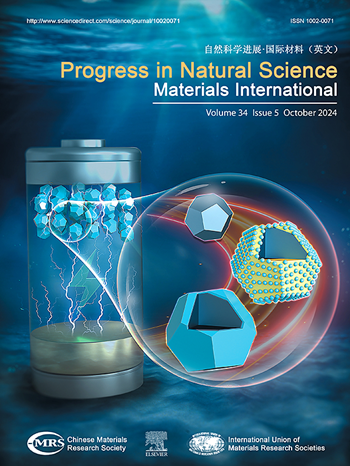A dual hydrogen bond crosslinking strategy for black phosphorus-based anodes in high rate capability lithium-ion batteries
IF 7.1
2区 材料科学
Q2 MATERIALS SCIENCE, MULTIDISCIPLINARY
Progress in Natural Science: Materials International
Pub Date : 2025-04-01
DOI:10.1016/j.pnsc.2025.02.010
引用次数: 0
Abstract
Black phosphorus (BP) has advantages over silicon and graphite in high-capacity fast charging. However, BP faces challenges such as low conductivity and volume expansion. Although composites of BP and graphite (G) can alleviate these problems to a certain extent, it is difficult to maintain the high performance of batteries at high current densities with conventional single binder systems. In this study, an innovative dual hydrogen bonding cross-linking strategy is proposed. The study used a cost-effective ball milling method to prepare BP-G composites and a hydrogen-bonded crosslinked polyacrylic acid (PAA)-poly(ethylene oxide) (PEO) binder to form hydrogen bonds with the BP. Hydrogen bonding cross-linking allows the binder to form a network structure, which effectively disperses the stresses. Hydrogen bonding exists between the binder and the BP. Ether bonds in the binder improve ionic migration. The degree of hydrogen bond crosslinking was optimized by adjusting the binder composition. The electrode material with the optimal binder ratio exhibited a discharge capacity of 1186 mAh g−1 at 8 A g−1. After 900 cycles, a reversible capacity of 771.8 mAh g−1 was maintained, with a capacity retention rate of 65.1 %, significantly outperforming electrodes using polyvinylidene fluoride (27.9 %) and PAA (19.3 %).

高倍率容量锂离子电池黑磷基阳极的双氢键交联策略
在高容量快速充电方面,黑磷(BP)比硅和石墨具有优势。然而,BP面临着低导电性和体积膨胀等挑战。虽然BP和石墨(G)的复合材料可以在一定程度上缓解这些问题,但传统的单一粘结剂体系很难在大电流密度下保持电池的高性能。在这项研究中,提出了一种创新的双氢键交联策略。该研究采用经济高效的球磨法制备BP- g复合材料,并用氢键交联聚丙烯酸(PAA)-聚环氧乙烷(PEO)粘结剂与BP形成氢键。氢键交联可使粘结剂形成网状结构,有效分散应力。粘结剂与BP之间存在氢键。粘合剂中的醚键促进离子迁移。通过调整粘结剂的组成,优化了氢键交联度。最佳粘结剂配比的电极材料在8 a g−1时的放电容量为1186 mAh g−1。经过900次循环后,电极的可逆容量保持在771.8 mAh g−1,容量保持率为65.1%,明显优于聚偏氟乙烯(27.9%)和PAA(19.3%)电极。
本文章由计算机程序翻译,如有差异,请以英文原文为准。
求助全文
约1分钟内获得全文
求助全文
来源期刊
CiteScore
8.60
自引率
2.10%
发文量
2812
审稿时长
49 days
期刊介绍:
Progress in Natural Science: Materials International provides scientists and engineers throughout the world with a central vehicle for the exchange and dissemination of basic theoretical studies and applied research of advanced materials. The emphasis is placed on original research, both analytical and experimental, which is of permanent interest to engineers and scientists, covering all aspects of new materials and technologies, such as, energy and environmental materials; advanced structural materials; advanced transportation materials, functional and electronic materials; nano-scale and amorphous materials; health and biological materials; materials modeling and simulation; materials characterization; and so on. The latest research achievements and innovative papers in basic theoretical studies and applied research of material science will be carefully selected and promptly reported. Thus, the aim of this Journal is to serve the global materials science and technology community with the latest research findings.
As a service to readers, an international bibliography of recent publications in advanced materials is published bimonthly.

 求助内容:
求助内容: 应助结果提醒方式:
应助结果提醒方式:


